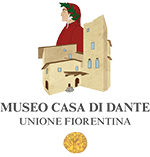A BRIEF HISTORY OF THE MUSEUM
The origins
To increase its value, the various subsequent owners expanded, renovated, and remodeled the property, changing it significantly from its original form. After a period when the Alighieri houses were readapted for various uses (storerooms, shops, homes) they fell into a state of decay. But the memory of the poet’s birthplace was kept alive in the popular tradition, which continued to indicate this group of humble and neglected houses as “Dante’s house.”
As can be deduced from Leonardo Bruni’s words in his Life of Dante (1436), even the Alighieri descendants, by this point settled in Verona for a long time, preserved a vague memory of the place:
Lionardo [Leonardo Alighieri, Dante’s great-grandson] came to Florence with other young men from Verona, well-appointed and honorably; and came to see me, as a friend of the memory of his ancestor Dante; and I showed him the houses of Dante and his forebears, and gave him information about many things that he did not know, since he and his family had moved away from the homeland.
FLORENCE AS CAPITAL (1865)
The city government resoves to buy the house Dante had lived in
Confirmation that the house lived in by the Alighieri family was located in just that spot comes from a document concerning a lawsuit brought by the prior of the church of San Martino al Vescovo against Dante’s family because of the roots of a fig tree on the Alighieri property which was ruining the wall around the church’s garden.
During the brief period when the capital, with a great deal of difficulty, was installed in the city, the most illustrious Florentines of the time, Bettino Ricasoli, several times prime minister of Italy, Ubaldino Peruzzi, the head of various ministries, and Luigi Guglielmo Cambray Digny, first mayor of the city and then Minister of Finance, just to mention the most important, were part of the government of the newly unified nation. Thus, with Ricasoli prime minister and Cambray mayor, on 17 March 1866 a commission was set up to carry out historical research on the house that once belonged to the author of the Divine Comedy.
[image type=”thumbnail” float=”right” link=”true” info=”tooltip” info_place=”left” info_trigger=”hover” src=”547″ alt=”Stemma Famiglia Alighieri” href=”http://museocasadidante.it/wp-content/uploads/2014/11/stemma-alighieri-museo-casa-di-dante.jpg” title=”Stemma Famiglia Alighieri” class=”scatolaleggera” style=”width:50%”]
The commission, made up of the lawyer Emilio Frullani, the historian Luigi Passerini, the professor Gaetano Bianchi and the architect Mariano Falcini, after two years of work presented to the City Council on 10 March 1868 a report on their investigation, which consisted of extensive research on the tax and property rolls from the early 1300s to the middle of the nineteenth century, archeological surveys, and maps on a scale of 1:140 of the “house inhabited by Dante Alighieri and adjacent properties.
THE CAPITAL IS MOVED TO ROME
The project to recover the House comes to a halt
1911: Recovery and Reconstruction
[lightbox selector=”.scatolaleggera” opacity=”0.875″ prev_scale=”0.75″ prev_opacity=”0.75″ next_scale=”0.75″ next_opacity=”0.75″ orientation=”vertical”]



